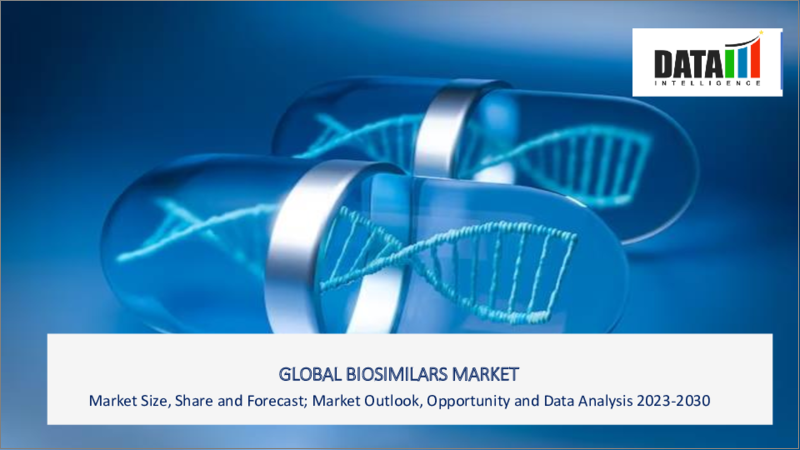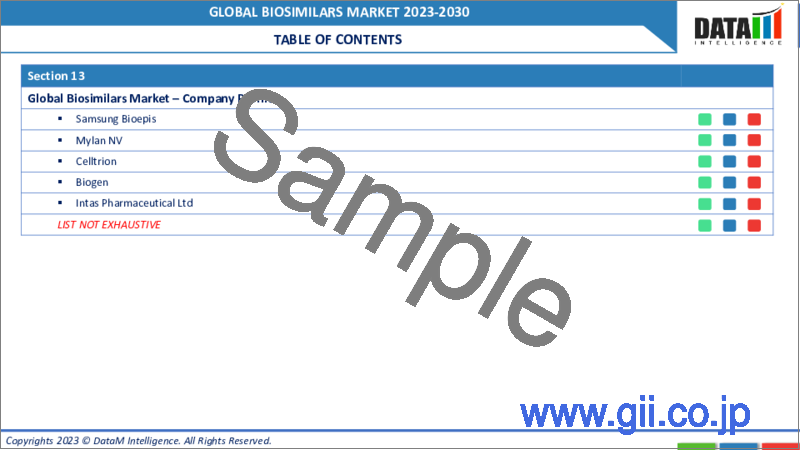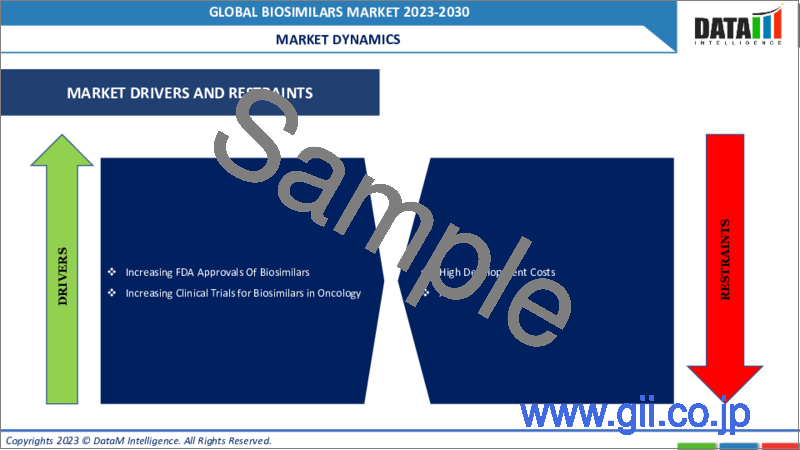|
|
市場調査レポート
商品コード
1297769
バイオシミラーの世界市場-2023年~2030年Global Biosimilars Market - 2023-2030 |
||||||
カスタマイズ可能
適宜更新あり
|
|||||||
| バイオシミラーの世界市場-2023年~2030年 |
|
出版日: 2023年06月15日
発行: DataM Intelligence
ページ情報: 英文 195 Pages
納期: 即日から翌営業日
|
- 全表示
- 概要
- 目次
市場概要
バイオシミラーの世界市場は、2022年に301億米ドルに達し、2030年には767億米ドルに達し、有利な成長が予測されています。バイオシミラーの世界市場は、2023年から2030年の予測期間中に12.8%のCAGRを示すと予測されています。
バイオシミラー医薬品は、同じ治療効果を維持しながら、より安価な代替品を提供することで、生物学的療法への患者のアクセスを向上させる機会を提供します。バイオシミラー医薬品は、ヘルスケアの持続可能性を高め、がん、自己免疫疾患、慢性炎症性疾患など、さまざまな疾病を抱える患者にとって利用可能な治療法の幅を広げるために不可欠です。
市場力学
慢性疾患の負担増が、予測期間中のバイオシミラー世界市場の成長を後押ししています
世界的に、がん、自己免疫疾患、糖尿病などの慢性疾患の有病率が上昇しています。バイオシミラーは、特定の疾患に対する経済的な治療選択肢を提供することで、患者の命を救う薬へのアクセスを改善します。バイオシミラーの需要は、慢性疾患の罹患率の上昇が原動力となっています。
WHOの2022年9月のデータ報告によると、NCDによる死亡の大部分(年間1,790万人)は心血管疾患によるもので、悪性腫瘍(930万人)、慢性呼吸器疾患(410万人)、糖尿病(糖尿病による腎疾患死を含む200万人)となっています。
FDA別バイオシミラー医薬品の承認は、世界のバイオシミラー医薬品市場に将来の成長機会をもたらします
食品医薬品局はバイオシミラー医薬品を承認し、安全で効率的なバイオシミラーの上市に必要な規制および科学的ガイダンスを提供しています。バイオシミラー医薬品の受け入れは、薬剤選択の幅を広げ、患者の医療費負担を軽減することで、患者の医療へのアクセスを向上させる可能性があります。例えば、2022年9月、FDAはVegzelma(bevacizumab-add)とStimufend(pegfilgrastim-FPGA)を承認しました。
COVID-19の影響分析
COVID-19パンデミックはバイオシミラー市場に大きな影響を与えています。バイオシミラーは、より合理的な価格の代替品を提供することで、必要な治療へのアクセスを向上させることができます。一部の生物製剤の需要が高まる可能性があるため、これは公衆衛生上の緊急事態が発生した場合に特に重要です。パンデミックの間、余分な仕事量を管理し、遠隔地での勤務体制を調整することは、世界中の規制当局にとって困難なことでした。このため、バイオシミラーの評価と承認が遅れている可能性があります。
ロシア・ウクライナ紛争分析
ロシア・ウクライナ紛争がバイオシミラー市場に与える影響は複雑かつ多面的です。世界の地政学的・経済的環境におけるリスクは、紛争シナリオによって引き起こされる可能性があります。投資家のリスク耐性が低下したり、他の領域に関心が移ったりする可能性があり、世界中のバイオシミラー研究開発プロジェクトへの投資や資金調達に影響を及ぼす可能性があります。
バイオシミラーの臨床試験には、複数の国や施設が関与します。紛争によってロシアやウクライナの治験施設へのアクセスが中断または制限されると、治験の完了、データ収集、規制当局の許可取得が遅れます。
目次
第1章 調査手法と範囲
第2章 定義と概要
第3章 エグゼクティブサマリー
第4章 市場力学
- 影響を与える要因
- 促進要因
- FDA別バイオシミラー医薬品の承認数の増加により、予測期間中の世界のバイオシミラー市場の成長が後押しされています。
- 抑制要因
- バイオシミラー医薬品の高い開発コストは、予測期間における世界のバイオシミラー市場の成長を妨げています。
- 機会
- 技術の進歩
- 影響分析
- 促進要因
第5章 業界分析
- ポーターのファイブフォース分析
- サプライチェーン分析
- アンメットニーズ
- 規制分析
第6章 COVID-19の分析
第7章 ロシアとウクライナの紛争分析
第8章 人工知能分析
第9章 製品別
- モノクローナル抗体
- 組換えヒト成長ホルモン(rhGH)
- インスリン
- 抗凝固剤
- エリスロポエチン
- 融合タンパク質
- 顆粒球コロニー刺激因子
- フォリトロピン
- その他
第10章 テクノロジー別
- 組換えDNA技術(rDNA技術)
- モノクローナル抗体(MAb)テクノロジー
第11章 アプリケーション別
- 腫瘍学
- 慢性疾患と免疫疾患
- 感染症
- 成長ホルモン欠乏症
- 血液疾患
- その他
第12章 流通チャネル別
- 病院薬局
- 小売薬局
- オンライン薬局
第13章 地域別
- 北米
- 米国
- カナダ
- メキシコ
- 欧州
- ドイツ
- 英国
- フランス
- イタリア
- スペイン
- その他欧州
- 南米
- ブラジル
- アルゼンチン
- その他南米
- アジア太平洋
- 中国
- インド
- 日本
- オーストラリア
- その他アジア太平洋地域
- 中東とアフリカ
第14章 競合情勢
- 競合シナリオ
- 製品のベンチマーク
- 企業シェア分析
- 主な発展と戦略
第15章 企業プロファイル
- Amgen Inc.
- 会社概要
- 製品ポートフォリオと説明
- 財務概要
- 主な発展
- Teva Pharmaceutical Industries Ltd.
- Novartis AG
- Pfizer Inc.
- Biocon
- Samsung Bioepis
- Mylan NV
- Celltrion
- Biogen
- Intas Pharmaceutical Ltd
第16章 付録
Market Overview
The Global Biosimilars Market reached US$ 30.1 billion in 2022 and is projected to witness lucrative growth by reaching up to US$ 76.7 billion by 2030. The Global Biosimilars Market is expected to exhibit a CAGR of 12.8% during the forecast period 2023-2030.
Biosimilars provide an opportunity to increase patient access to biological therapies by offering more affordable alternatives while maintaining the same therapeutic benefits. They can be essential in enhancing the sustainability of healthcare and broadening the range of available treatments for patients with different illnesses, such as cancer, autoimmune diseases, and chronic inflammatory problems.
Market Dynamics
The growing burden of chronic diseases is boosting the global biosimilars market growth during the forecast period.
Globally, the prevalence of chronic conditions like cancer, autoimmune illnesses, and diabetes is rising. Biosimilars improve patient access to medications that can save their lives by providing economic treatment alternatives for certain ailments. The demand for biosimilars is driven by the rising incidence of chronic diseases.
According to the WHO data report September 2022, the majority of NCD deaths, or 17.9 million people yearly, are caused by cardiovascular illnesses, followed by malignancies (9.3 million), chronic respiratory diseases (4.1 million), and diabetes (2.0 million including renal disease deaths caused by diabetes).
Approval of biosimilar drugs by the FDA provides the Global Biosimilars Market with future growth opportunities.
The Food and Drug Administration approves biosimilar products and offers the regulatory and scientific guidance required to launch safe and efficient biosimilars. The acceptance of biosimilar pharmaceuticals can increase patient access to care by expanding their selection of medications and possibly lowering their expenses. For instance, in September 2022, FDA approved Vegzelma (bevacizumab-add) and Stimufend (pegfilgrastim-FPGA).
COVID-19 Impact Analysis
The COVID-19 pandemic has had a significant impact on the biosimilars market. Biosimilars can enhance access to essential treatments by providing more reasonably priced alternatives. This is especially important when there is a public health emergency since the demand for some biologics can go up. Managing the extra workload and adjusting to remote work arrangements during the pandemic has been difficult for regulatory agencies worldwide. The evaluation and approval of biosimilars may have been delayed due to this.
Russia-Ukraine Conflict Analysis
The impact of the Russia-Ukraine war on the Biosimilars market is complex and multifaceted. Risks in the geopolitical and economic environment of the world can be caused by conflict scenarios. Investors may become less risk-tolerant or divert their attention to other domains, which could influence investments and funding for biosimilar research and development projects worldwide.
Clinical trials for biosimilars involve several nations and sites. Trial completion, data collection, and gaining regulatory permissions are delayed when the conflict interrupts or restricts access to trial locations in Russia or Ukraine.
Segment Analysis
The global biosimilar market is segmented based on product, technology, application, distribution channel, and region.
The monoclonal antibodies segment is expected to hold a dominant position in the market over the forecast period.
The monoclonal antibodies segment accounted for the highest market stake, accounting for approximately 1/2nd of the Biosimilars market in 2022. The family of biosimilar molecules includes biosimilar monoclonal antibodies (mAbs). Large, complex proteins are typically used to treat conditions like cancer or rheumatoid arthritis. They are employed by the immune system to recognize and destroy invading substances, including bacteria, viruses, and others.
For instance, in September 2022, Biogen Inc., a biotechnology company, declared that the European Medicines Agency had accepted the Marketing Authorization Application for BIIB800, a biosimilar candidate referencing RoACTEMRA (tocilizumab), an anti-interleukin-6 receptor monoclonal antibody.
Geographical Analysis
Increasing collaborations and partnerships among the key players, increasing FDA approvals, and advancement in Biosimilars dominate the North American region.
North America is expected to dominate the Biosimilars market, accounting for around 32.1% of this market. For instance, An expedited FDA approval process for biosimilars is used to increase patient access to high-quality, lower-cost healthcare. In the United States as of January 2022, there were 33 biosimilars that had received FDA approval, 21 of which were currently being sold.
According to the cardinal health report 2022, in cancer, where all three classes of therapeutic oncology biosimilars-namely, rituximab, bevacizumab, and trastuzumab-have topped 60% market share, significant progress has been made in the adoption of biosimilars in the U.S.
Competitive Landscape
The major global players in the market include: Amgen Inc., Teva Pharmaceutical Industries Ltd., Novartis AG, Pfizer Inc., Biocon, Samsung Bioepis, Mylan NV, Celltrion, Biogen, and Intas Pharmaceutical Ltd among others.
Why Purchase the Report?
- To visualize the Global Biosimilar Market segmentation based on the product, technology, application, distribution channel, and region, as well as understand key commercial assets and players.
- Identify commercial opportunities by analyzing trends and co-development.
- Excel data sheet with numerous data points of Biosimilars market-level with all segments.
- PDF report consists of a comprehensive analysis after exhaustive qualitative interviews and an in-depth study.
- Product mapping available as Excel consisting of key products of all the major players.
The Global Biosimilars Market Report Would Provide Approximately 69 Tables, 70 Figures And 195 pages.
Target Audience 2023
- Manufacturers/ Buyers
- Industry Investors/Investment Bankers
- Research Professionals
- Emerging Companies
Table of Contents
1. Methodology and Scope
- 1.1. Research Methodology
- 1.2. Research Objective and Scope of the Report
2. Definition and Overview
3. Executive Summary
- 3.1. Snippet by Product
- 3.2. Snippet by Technology
- 3.3. Snippet by Application
- 3.4. Snippet by Distribution Channel
- 3.5. Snippet by Region
4. Dynamics
- 4.1. Impacting Factors
- 4.1.1. Drivers
- 4.1.1.1. An increasing number of biosimilar drug approvals by the FDA is boosting the global biosimilar market growth during the forecast period.
- 4.1.2. Restraints
- 4.1.2.1. High development costs of the biosimilar drug are hampering the growth of the global biosimilar market in the forecast period.
- 4.1.3. Opportunity
- 4.1.3.1. Technological advancements
- 4.1.4. Impact Analysis
- 4.1.1. Drivers
5. Industry Analysis
- 5.1. Porter's 5 Forces Analysis
- 5.2. Supply Chain Analysis
- 5.3. Unmet Needs
- 5.4. Regulatory Analysis
6. COVID-19 Analysis
- 6.1. Analysis of COVID-19
- 6.1.1. Scenario Before COVID-19
- 6.1.2. Scenario During COVID-19
- 6.1.3. Post COVID-19 & Future Scenario
- 6.2. Pricing Dynamics Amid COVID-19
- 6.3. Demand-Supply Spectrum
- 6.4. Government Initiatives Related to the Market During the Pandemic
- 6.5. Manufacturers' Strategic Initiatives
- 6.6. Conclusion
7. Russia-Ukraine Conflict Analysis
8. Artificial Intelligence Analysis
9. By Product
- 9.1. Introduction
- 9.1.1. Market Size Analysis and Y-o-Y Growth Analysis (%), By Product
- 9.1.2. Market Attractiveness Index, By Product
- 9.2. Monoclonal Antibodies*
- 9.2.1. Introduction
- 9.2.2. Market Size Analysis and Y-o-Y Growth Analysis (%)
- 9.3. Recombinant Human Growth Hormone (rhGH)
- 9.4. Insulin
- 9.5. Anti-coagulants
- 9.6. Erythropoietin
- 9.7. Fusion Proteins
- 9.8. Granulocyte Colony Stimulating Factor
- 9.9. Follitropin
- 9.10. Others
10. By Technology
- 10.1. Introduction
- 10.1.1. Market Size Analysis and Y-o-Y Growth Analysis (%), By Technology
- 10.1.2. Market Attractiveness Index, By Technology
- 10.2. Recombinant DNA Technology (rDNA technology)*
- 10.2.1. Introduction
- 10.2.2. Market Size Analysis and Y-o-Y Growth Analysis (%)
- 10.3. Monoclonal Antibodies (MAb) Technology
11. By Application
- 11.1.1. Market Size Analysis and Y-o-Y Growth Analysis (%), By Application
- 11.1.2. Market Attractiveness Index, By Application
- 11.2. Oncology*
- 11.2.1. Introduction
- 11.2.2. Market Size Analysis and Y-o-Y Growth Analysis (%)
- 11.3. Chronic and Immune Diseases
- 11.4. Infectious Diseases
- 11.5. Growth Hormone Deficiency
- 11.6. Blood Disorders
- 11.7. Others
12. By Distribution Channel
- 12.1. Introduction
- 12.1.1. Market Size Analysis and Y-o-Y Growth Analysis (%), By Distribution Channel
- 12.1.2. Market Attractiveness Index, By Distribution Channel
- 12.2. Hospital Pharmacies*
- 12.2.1. Introduction
- 12.2.2. Market Size Analysis and Y-o-Y Growth Analysis (%)
- 12.3. Retail Pharmacies
- 12.4. Online Pharmacies
13. By Region
- 13.1. Introduction
- 13.1.1. Market Size Analysis and Y-o-Y Growth Analysis (%), By Region
- 13.1.2. Market Attractiveness Index, By Region
- 13.2. North America
- 13.2.1. Introduction
- 13.2.2. Key Region-Specific Dynamics
- 13.2.3. Market Size Analysis and Y-o-Y Growth Analysis (%), By Product
- 13.2.4. Market Size Analysis and Y-o-Y Growth Analysis (%), By Technology
- 13.2.5. Market Size Analysis and Y-o-Y Growth Analysis (%), By Application
- 13.2.6. Market Size Analysis and Y-o-Y Growth Analysis (%), By Distribution Channel
- 13.2.7. Market Size Analysis and Y-o-Y Growth Analysis (%), By Country
- 13.2.7.1. The U.S.
- 13.2.7.2. Canada
- 13.2.7.3. Mexico
- 13.3. Europe
- 13.3.1. Introduction
- 13.3.2. Key Region-Specific Dynamics
- 13.3.3. Market Size Analysis and Y-o-Y Growth Analysis (%), By Product
- 13.3.4. Market Size Analysis and Y-o-Y Growth Analysis (%), By Technology
- 13.3.5. Market Size Analysis and Y-o-Y Growth Analysis (%), By Application
- 13.3.6. Market Size Analysis and Y-o-Y Growth Analysis (%), By Distribution Channel
- 13.3.7. Market Size Analysis and Y-o-Y Growth Analysis (%), By Country
- 13.3.7.1. Germany
- 13.3.7.2. The U.K.
- 13.3.7.3. France
- 13.3.7.4. Italy
- 13.3.7.5. Spain
- 13.3.7.6. Rest of Europe
- 13.4. South America
- 13.4.1. Introduction
- 13.4.2. Key Region-Specific Dynamics
- 13.4.3. Market Size Analysis and Y-o-Y Growth Analysis (%), By Product
- 13.4.4. Market Size Analysis and Y-o-Y Growth Analysis (%), By Technology
- 13.4.5. Market Size Analysis and Y-o-Y Growth Analysis (%), By Application
- 13.4.6. Market Size Analysis and Y-o-Y Growth Analysis (%), By Distribution Channel
- 13.4.7. Market Size Analysis and Y-o-Y Growth Analysis (%), By Country
- 13.4.7.1. Brazil
- 13.4.7.2. Argentina
- 13.4.7.3. Rest of South America
- 13.5. Asia-Pacific
- 13.5.1. Introduction
- 13.5.2. Key Region-Specific Dynamics
- 13.5.3. Market Size Analysis and Y-o-Y Growth Analysis (%), By Product
- 13.5.4. Market Size Analysis and Y-o-Y Growth Analysis (%), By Technology
- 13.5.5. Market Size Analysis and Y-o-Y Growth Analysis (%), By Application
- 13.5.6. Market Size Analysis and Y-o-Y Growth Analysis (%), By Distribution Channel
- 13.5.7. Market Size Analysis and Y-o-Y Growth Analysis (%), By Country
- 13.5.7.1. China
- 13.5.7.2. India
- 13.5.7.3. Japan
- 13.5.7.4. Australia
- 13.5.7.5. Rest of Asia-Pacific
- 13.6. Middle East and Africa
- 13.6.1. Introduction
- 13.6.2. Key Region-Specific Dynamics
- 13.6.3. Market Size Analysis and Y-o-Y Growth Analysis (%), By Product
- 13.6.4. Market Size Analysis and Y-o-Y Growth Analysis (%), By Technology
- 13.6.5. Market Size Analysis and Y-o-Y Growth Analysis (%), By Application
- 13.6.6. Market Size Analysis and Y-o-Y Growth Analysis (%), By Distribution Channel
14. Competitive Landscape
- 14.1. Competitive Scenario
- 14.2. Product Benchmarking
- 14.3. Company Share Analysis
- 14.4. Key Developments and Strategies
15. Company Profiles
- 15.1. Amgen Inc.*
- 15.1.1. Company Overview
- 15.1.2. Product Portfolio and Description
- 15.1.3. Financial Overview
- 15.1.4. Key Developments
- 15.2. Teva Pharmaceutical Industries Ltd.
- 15.3. Novartis AG
- 15.4. Pfizer Inc.
- 15.5. Biocon
- 15.6. Samsung Bioepis
- 15.7. Mylan NV
- 15.8. Celltrion
- 15.9. Biogen
- 15.10. Intas Pharmaceutical Ltd
LIST NOT EXHAUSTIVE
16. Appendix
- 16.1. About Us and Services
- 16.2. Contact Us





